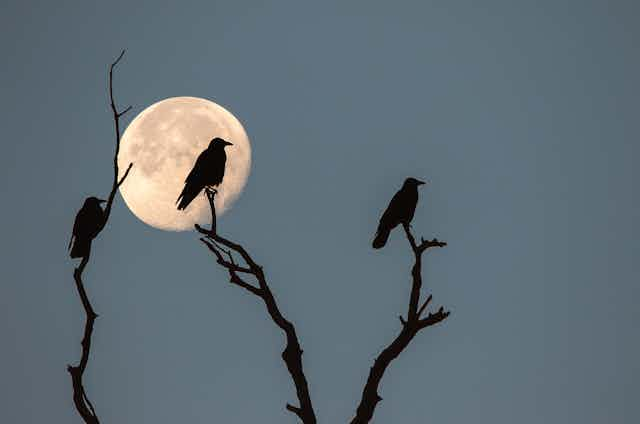Bird conservation has a long and rich history in Britain. This is driven, in part, by the popular – and very British – pastime of bird-feeding, which can be traced back to St Cuthbert in 7th-century Northumberland. The Lindisfarne monk also introduced one of the first bird protection laws.
This British love affair with birds resulted in the founding of the Society for the Protection of Birds in 1889, which this year celebrates 120 years in existence as the Royal Society for the Protection of Birds (royal assent was conferred in 1904). The RSPB is now at the vanguard of British conservation in protecting wild places for birds. With 1.2 million members, many volunteers spend thousands of hours working to protect birds and wildlife – but how did it all begin?
Conor Jameson’s recent book, Finding WH Hudson: The Writer Who Came to Britain to Save the Birds, attempts to answer this question by providing a view of Victorian attitudes towards birds through the eyes of an unknown South American naturalist and ornithologist, William Henry Hudson.
After working for the RSPB for 25 years, Jameson sought to uncover the secrets of this mysterious hero of British bird conservation – “the man above the fireplace”, whose gaze was ever-present thanks to his portrait hanging in the main meeting room at the RSPB headquarters.

The man from Argentina
Born in Argentina to US settlers in 1841, Hudson made England his home after arriving in May 1874 at the age of 32. It did not take long for him to gain prominence as an ornithologist of considerable repute. In 1888-1889 he co-authored a major two-volume book about Argentine birds with Philip Sclater, founder of The Ibis, the journal of the British Ornithologists’ Union.
His writing was strongly influenced by Reverend Gilbert White, who, a century earlier, had produced one of the first and greatest works of natural history, The Natural History and Antiquities of Selborne, describing in passionate detail his observations of nature in his parish.
Hudson’s powers of natural-history observation, and indeed his candour in his writing, were evidently influenced by White whose grave he visited on more than one occasion to pay his respects.

Coming from South America, even common bird species in England were new to Hudson. As a result, he keenly observed them as his considerable naturalist’s skills came to the fore.
Once in England he quickly threw his support behind the “campaigning women of Manchester and London” represented by founder of the Society for the Protection of Birds (SPB) Emily Williamson, and co-founders of the Fur, Fin and Feather Folk, Eliza Phillips and Etta Lemon. The two societies joined forces in the early 1890s as the SPB with the “R” prefix added in 1904.
It is clear that Hudson did not seek the limelight, preferring instead to campaign strenuously “behind the scenes”. One example includes writing a letter to The Times newspaper in 1898 to suggest that Queen Charlotte’s cottage and its gardens at Kew be gifted to the nation. It came to pass in the same year.
Changing attitudes to birds
So, how did an unknown Argentinian rise to change entrenched social attitudes towards birds in Britain? Hudson moved in circles of influence in London, containing luminaries such as the future Nobel Prize for literature winner, John Galsworthy, author of The Forsyte Saga, who shared his abhorrence of the poor treatment of birds by upper-class fashionistas and collectors.
Hudson came to England at a time when the Victorian fashion for feathered hats was at its peak, though it came at a dreadful cost for birds. For example, one London fashion dealer placed a single order in 1892 for 6,000 bird-of-paradise, 40,000 hummingbird and 360,000 East Indian bird feathers. It pained Hudson that feathers were being used so cavalierly as dress accessories for high-society ladies.

He regularly wrote articulate and passionate letters to national newspapers about the persecution of birds, including long-line fishing for albatrosses and catching gulls using baited hooks. He even wrote about the incompatibility of golfers and birds, deeming it an “absurd game” that endangered flying creatures and their habitat.
Given his mounting influence on bird conservation, it seems strange that Hudson is not better known. While he was a prolific writer whose books attracted critical acclaim, he was no grand orator. As Jameson implies, his aversion to public speaking bordered on the pathological. The book is full of examples of invitations that he rarely took up, and it seems that he preferred to write rather than travel. His opinion was sought by fellow writers to whom he gave rather blunt feedback. Today, these traits may well have led to him being called a loner.
I smiled when reading about Hudson’s love of rooks (which belong to the crow family, known as corvids), mentioned several times in the book. I wonder whether subconsciously Hudson saw himself reflected in this often misunderstood yet intriguing species.
The book is rich in biographical details about Hudson that have been lovingly and comprehensively researched by the author. The narrative flows smoothly, is eminently readable and provides great insight into a man who was clearly enchanted by the natural world – which is probably why he went to great lengths to protect it.
Frustratingly, however, there is little or no detail about Hudson’s formative years in his homeland. This is perhaps because Hudson destroyed many letters he received and encouraged recipients of his letters to do the same. That said, a timeline of events and achievements that shaped Hudson’s impressive career would have added to the book’s navigability.
But the author has done bird lovers a great service in shining a light on this little-known yet fascinating avian conservation pioneer. Though he never sought it, Hudson deserves this posthumous limelight.

